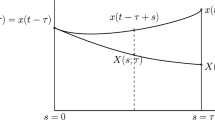Abstract
A global branch of positive cycles is shown to exist for a general discrete time, juvenile-adult model with periodically varying coefficients. The branch bifurcates from the extinction state at a critical value of the mean, inherent fertility rate. In comparison to the autonomous system with the same mean fertility rate, the critical bifurcation value can either increase or decrease with the introduction of periodicities. Thus, periodic oscillations in vital parameter can be either advantageous or deleterious. A determining factor is the phase relationship among the oscillations in the inherent fertility and survival rates.
Similar content being viewed by others
References
Caswell, H .: Matrix Population Models: Construction, Analysis and Interpretation, 2nd edn. Sunderland, Massachusetts: Sinauer Associates, Inc. Publishers, 2001
Coleman, B.D.: On the growth of populations with narrow spread in reproductive age. I. General theory and examples. J. Math. Biol. 6, 1–19 (1978)
Costantino, R.F., Cushing, J.M., Dennis, B., Desharnais, R.A., Henson, S.M.: Resonant population cycles in temporally fluctuating habitats. Bull. Math. Biol. 60 (2), 247–275 (1998)
Cushing, J.M.: Periodic time-dependent predator prey systems. SIAM J. Appl. Math. 23, 972–979 (1977)
Cushing, J.M.: Periodic Kolomogov systems. SIAM J. Appl. Math. 13, 811–827 (1982)
Cushing, J.M.: Periodic two-predator, one-prey interactions and the time sharing of a resource niche. SIAM J. Appl. Math. 44, 392–410 (1984)
Cushing, J.M.: Periodic Lotka-Volterra competition equations. J. Math. Biol. 24, 381–403 (1986)
Cushing, J.M.: Oscillatory population growth in periodic environments. Theor. Popu. Biol. 30, 289–308 (1987)
Cushing, J.M.: An Introduction to Structured Population Dynamics. CBMS-NSF Regional Conference Series in Applied Mathematics, Vol. 71. Philadelphia: SIAM, 1998
Cushing, J.M.: Periodically forced nonlinear systems of difference equations. J. Diff. Equ. and Appl. 3, 547–561 (1998)
Cushing, J.M., Henson, S.M.: Global dynamics of some periodically forced, monotone difference equations. J. Diff. Equ. Appl. 7, 859–872 (2001)
deMottoni, P., Schiaffino, A.: Competition systems with periodic coefficients: a geometrical approach. J. Math. Biol. 11, 319–335 (1982)
Elaydi, S.N.: An Introduction to Difference Equations. Springer-Verlag, New York, 1996
Elaydi, S., Sacker, R.J.: Global stability of periodic orbits of non-autonomous difference equations and population biology. J. Diff. Equ. 208, 258–273 (2005)
Elaydi, S., Sacker, R.J.: Non-autonomous Beverton-Holt equations and the Cushing-Henson conjectures. J. Diff. Equ. Appl. 11, 337–346 (2005)
Elaydi, S., Sacker, R.J.: Global stability of periodic orbits of non-autonomous difference equations in population biology and the Cushing/Henson conjectures. In: Proceedings of the 8th International Conference of Difference Equations and Applications, pp. 113-126, Chapman & Hall/CRC, Boca Raton, FL, 2005
Franke, J.E., Yakubu, A.-A.: Multiple attractors via CUSP bifurcation in periodically varying environments. J. Diff. Equ. Appl. 11, 365–377 (2005)
Franke, J.E., Yakubu, A.-A.: Attenuant cycles in periodically forced discrete-time age-structured population models, J. Math. Analy. Appl. 316, 69–86 (2006)
Franke, J.E., Yakubu, A.-A.: Population models with periodic recruitment functions and survival rates, J. Diff. Equ. Appl. 11 (14), 1169–1184 (2005)
Franke, J.E., Yakubu, A.-A.: Globally attracting attenuant versus resonant cycles in periodic compensatory Leslie models, to appear
Franke, J.E., Yakubu, A.-A.: Signature function for predicting resonant and attenuant population cycles, to appear in Bull. Math. Biol.
Henson, S.M.: Existence and stability of nontrivial periodic solutions of periodically forced discrete dynamical systems. J. Diff. Equ. and Appl. 2, 315–331 (1996)
Henson, S.M.: The effect of periodicity in maps. J. Diff. Equ. Appl. 5, 31–56 (1999)
Henson, S.M.: Multiple attractors and resonance in periodically forced population models. Physica D 140, 33–49 (2000)
Henson, S.M., Cushing, J.M.: The effect of periodic habitat fluctuations on a nonlinear insect population model. J. Math. Biol. 36, 201–226 (1997)
Jillson, D.A.: Insect populations respond to fluctuating environments. Nature 288, 699–700 (1980)
Kielhöfer, H.: Bifurcation Theory: An Introduction with Applications to PDEs. Applied Mathematical Sciences 156, Springer, New York, 2004
Kocic, V.L.: A note on the non-autonomous Beverton-Holt model, J. Diff. Equ. Appl. 11 (4–5), 415–422 (2005)
Kon, R.: A note on attenuant cycles of population models with periodic carrying capacity. J. Diff. Equ. Appl. 10 (8), 791–793 (2004)
Kon, R.: Attenuant cycles of population models with periodic carrying capacity. J. Diff. Equ. Appl. 11, 423–430 (2005)
May, R.M.: Stability and Complexity in Model Ecosystems. Princeton Landmarks in Biology, Princeton University Press, Princeton, New Jersey, 2001, p. 123
Namba, T.: Competitive co-existence in a seasonally fluctuating environment. J. Theo. Biol. 111, 369–386 (1984)
Nisbet, R.M., Gurney, W.S.C.: Population dynamics in a periodically varying environment. J. Theo. Biol. 56, 459–475 (1976)
Rabinowitz, P.H.: Some global results for nonlinear eigenvalue problems. J. Func. Anal. 7 (3), 487-513b (1971)
Rosenblat, S.: Population models in a periodically fluctuating environment. J. Math. Biol. 9, 23–36 (1980)
Slegrade, J.F., Roberds, J.H.: On the structure of attractors for discrete, periodically forced systems with applications to population models. Physica D 158, 69–82 (2001)
Smith, H.L.: Competitive coexistence in an oscillating chemostst. SIAM J. Appl. Math. 40, 498–522 (1981)
Smith, H.L., Waltman, P.: The Theory of the Chemostat: Dynamics of Microbial Competition. Cambridge Studies in Mathematical Biology, Cambridge University Press, Cambridge, 1995
Author information
Authors and Affiliations
Additional information
Research supported by NSF grant DMS-0414212.
Rights and permissions
About this article
Cite this article
Cushing, J. A juvenile-adult model with periodic vital rates. J. Math. Biol. 53, 520–539 (2006). https://doi.org/10.1007/s00285-006-0382-6
Received:
Revised:
Published:
Issue Date:
DOI: https://doi.org/10.1007/s00285-006-0382-6




